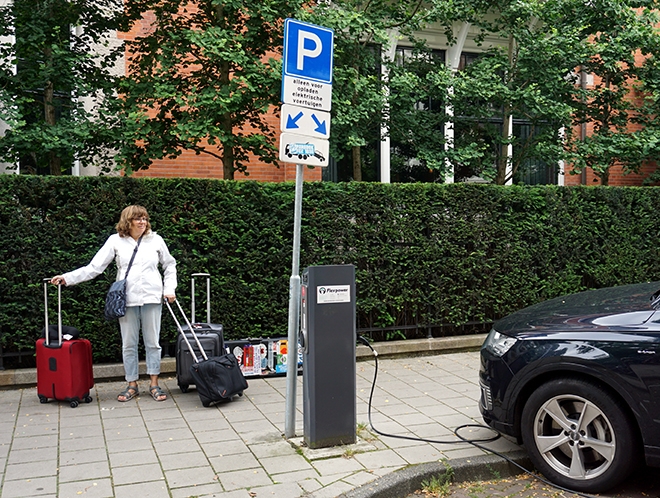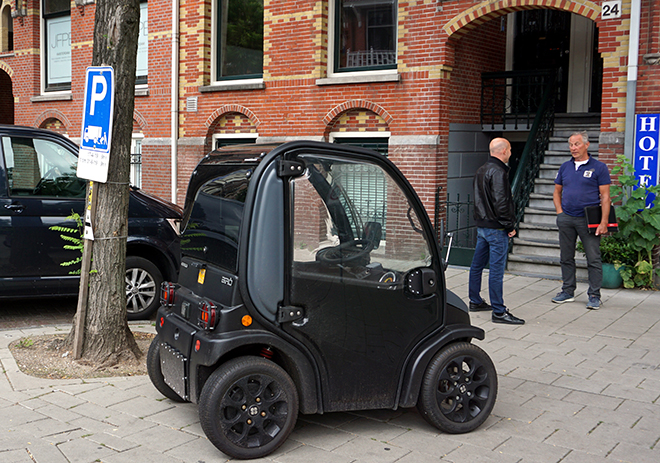The streets of Amsterdam are a chaotic carnival of
transportation options: the famous flotilla of bicycles (which have dedicated
lanes on all major streets) shares the cobblestones with skateboards, scooters
(gas, electric and pedal), Segways, buses (diesel and electric) and street
trams. There are also canal boats, an underground Metro system, and of course
automobiles of every size and propulsion option.
The visitor will feel the voltage on arrival at Schiphol airport, which is served by a fleet of electric taxis. Taxi company BIOS-groep deployed a fleet of 167 Model S sedans in 2014 (as reported by Electrek). Last December, the company announced that, out of one million airport rides in 2018, 70% were provided by Tesla taxis. Today the picture is even more diverse – you’ll also see Model X, LEAF and Hyundai Kona taxis. The Teslas charge at a large private parking lot full of Superchargers just outside the airport.


E-buses are also in evidence. Over 100 battery-electric buses serve as airport shuttles (Schiphol says this is Europe’s largest e-bus fleet, and that it will have 258 in service by 2021). The Citea buses, built by the Dutch firm VDL, each have a battery capacity of 170 kWh and a range of 80 km. The charging infrastructure (from Heliox, another local company) includes 450 kWh fast chargers that top up the buses between journeys and 30 kWh chargers for overnight charging at the depot. A separate fleet of e-buses, also made by VDL, serves some of the routes connecting the airport with nearby cities.


Once you get into town, you’ll find Amsterdam to be second only to Oslo in terms of the number and variety of plug-in vehicles gliding around the streets. In a day, I saw all four Tesla models, lots of LEAFs, i3s, smarts, e-Golfs, Zoes and Konas, as well as PHEVs from Audi, BMW, Mercedes, Porsche and other European makes. There are also several brands of tiny city cars, both gas and electric, including some that look like they’ve been on the road since the 1970s.
The Birò, a two-seat NEV (officially a “light quadricycle moped”) is extremely popular in Holland. Made by the Italian startup Estrima since 2009, it’s available with either a lead-acid or lithium-ion battery, and plugs into a household outlet. It’s driven by two 48 V wheel-mounted motors (4 kW total power); maximum speed is up to 34 mph and range is up to about 43 miles. The Birò seems to be a prophet without honor in its home country: in one day in Amsterdam, I saw dozens; in a week of traveling around Italy, I saw only one.


Most of Amsterdam’s picturesque canals are lined by tree-shaded parking spaces, and a growing number of these include public charging stations (with signs clearly indicating that ICE vehicles will be towed!). By some estimates, the metro area has over 3,000 charging points, but it’s going to need a lot more. The city government has proposed a ban on fossil fuel vehicles within the city center, to be phased in by 2030. As is the case in many cities in Europe (and in parts of the US), very few residents have garages, or even assigned parking spaces, so eventually most or all public parking spaces will need to incorporate charging. Amsterdam is poised to become an early case study for the development of an all-electric city, a topic which I plan to address in depth in a future article in Charged. Tot ziens!


















































